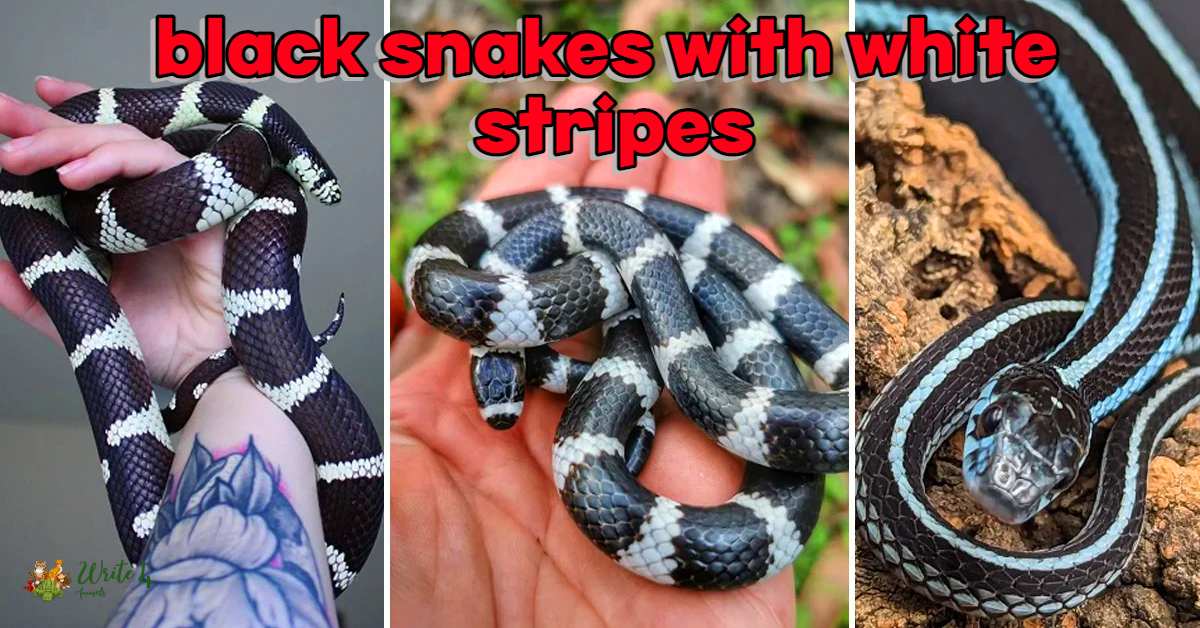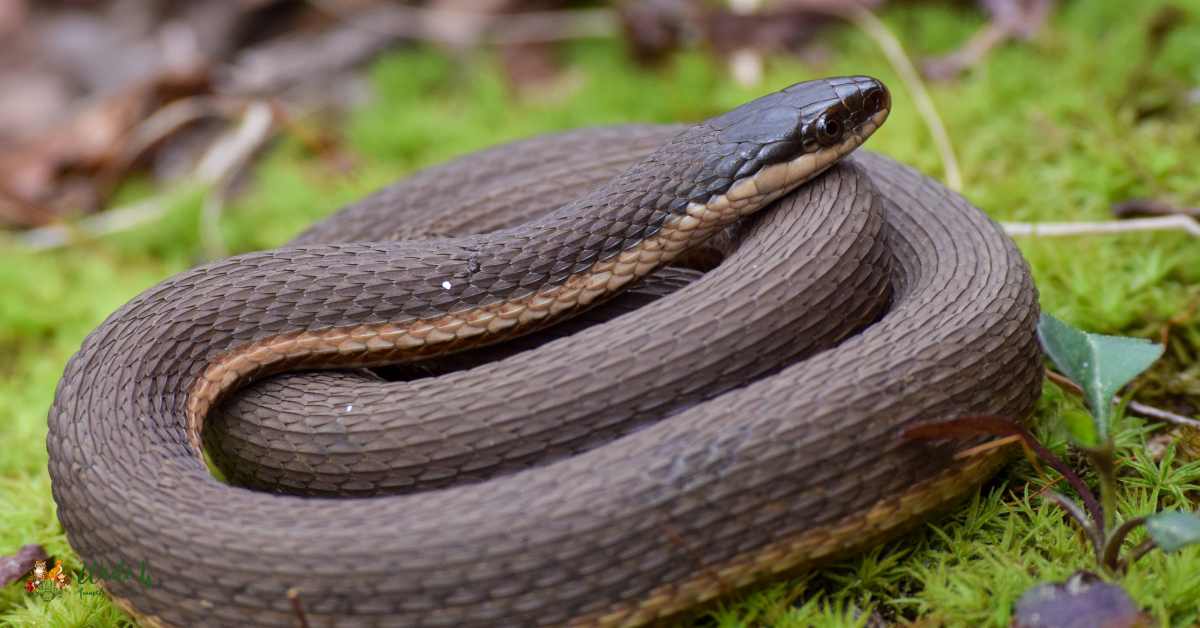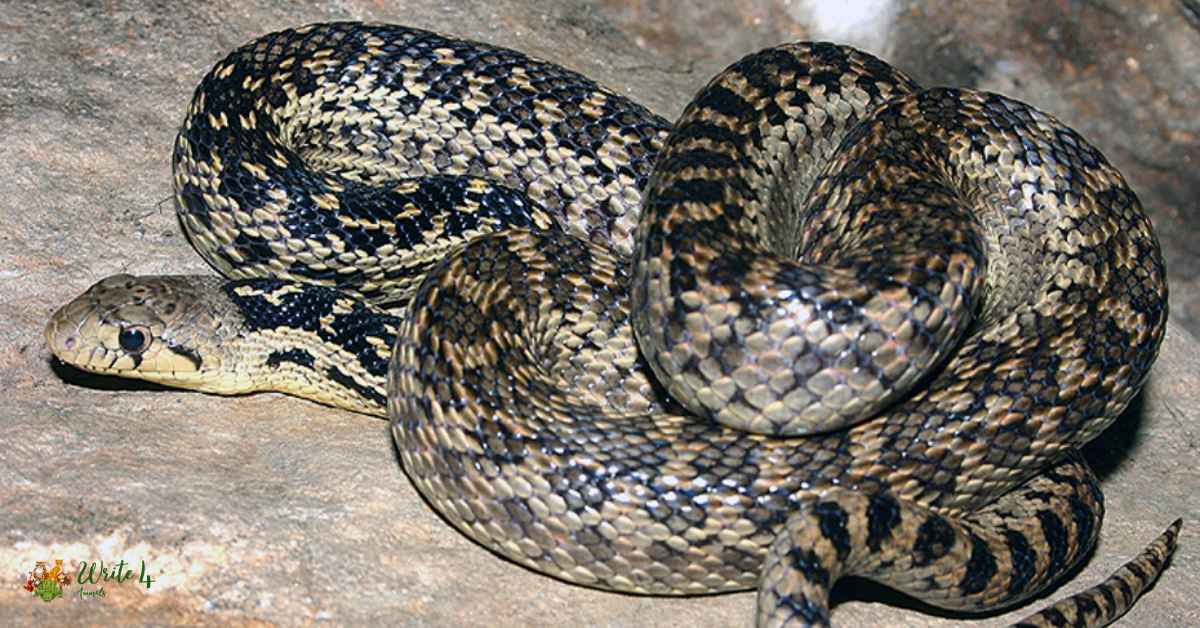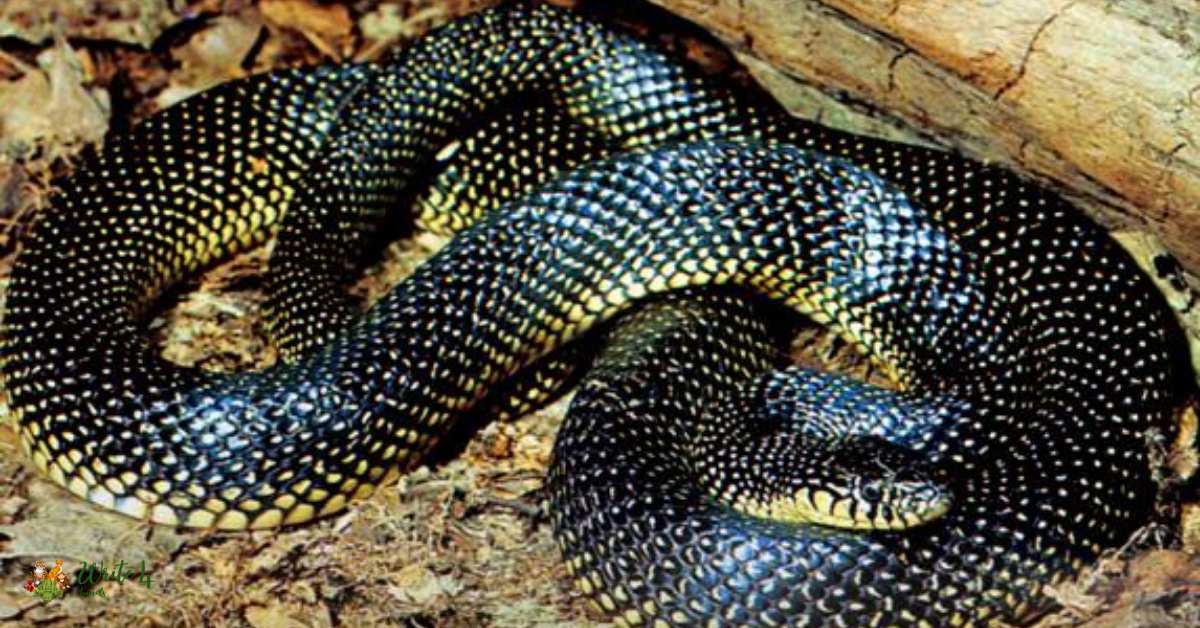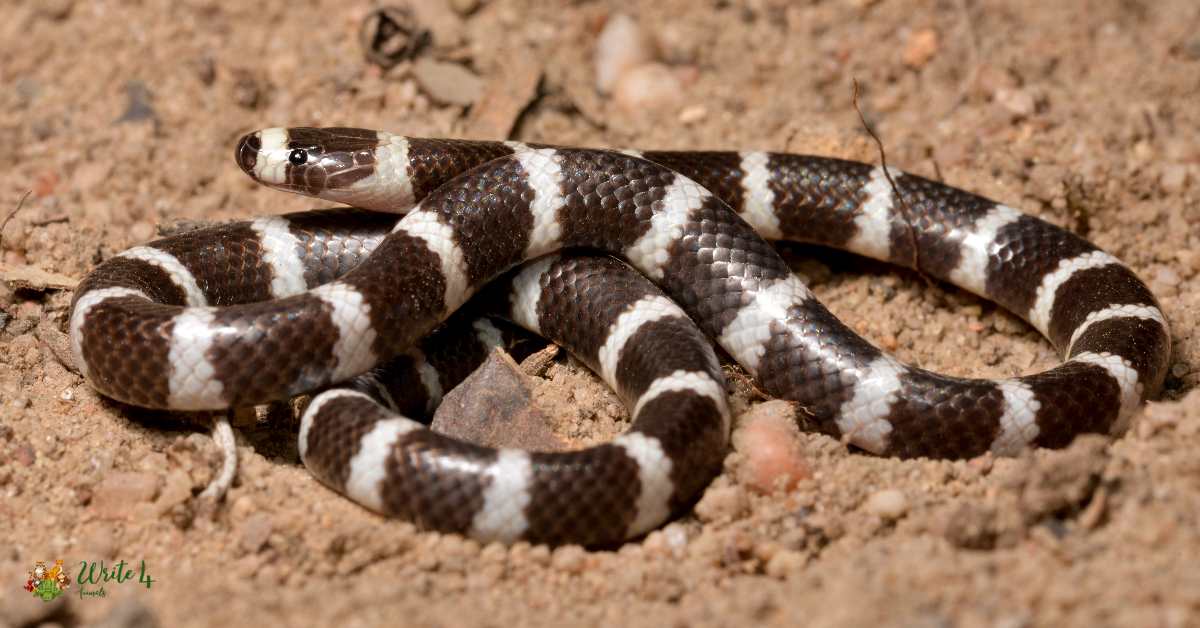Discover the captivating world of black snakes with white stripes, where nature’s artistic flair takes center stage. These enigmatic serpents, adorned with striking white patterns against their dark scales, beckon us into the mysteries of the animal kingdom. In this blog post, we’ll delve into the fascinating features, habitats, and behaviors of these unique creatures.
Whether you’re a nature enthusiast or simply curious, join us on a journey to unravel the secrets behind the visually stunning black snake with white stripes, showcasing how beauty and intrigue seamlessly intertwine in the realm of serpentine wonders.
17 Black snake with white stripes
1. Queen Snake
The Queen Snake, a water-loving serpent native to the eastern United States, features a glossy black body adorned with distinct black white striped snake. Its unique appearance is complemented by its exceptional aquatic prowess, specializing in hunting crayfish.
The white stripes on its dark scales not only serve as an aesthetic marvel but also contribute to its cryptic presence in riparian habitats. The Queen Snake’s slender form, coupled with its elegant markings, showcases the fascinating adaptations these serpents undergo for survival in diverse ecosystems, making it a captivating species for nature enthusiasts and researchers alike.
2. Gopher Snake
The Gopher Snake, a North American native, commands attention with its sleek black body marked by prominent white stripes. These distinctive patterns not only add to its visual appeal but also play a crucial role in its survival.
Serving as both camouflage and a warning to potential threats, the Gopher Snake’s appearance reflects its adaptability in a variety of environments. With a habitat ranging from grasslands to deserts, this snake’s striking black-and-white attire showcases the adaptability and resilience that make it a notable resident of diverse landscapes.
3. Southern Black Racer
The Southern Black Racer, known for its speed and agility, boasts a jet-black body adorned with prominent white markings, creating a visually striking contrast. This snake is a common sight in the southeastern United States and is often found in a variety of habitats, including open fields and wooded areas.
The sleek, slender form of the Southern Black Racer, coupled with its distinct coloration, serves both functional and aesthetic purposes. The white stripes not only contribute to its visual appeal but may also play a role in temperature regulation, camouflage, or communication within its ecosystem.
As a result, the Southern Black Racer stands as a testament to the beauty and adaptability of nature’s serpentine wonders.
4. Banded California Snake
Hailing from the vast landscapes of Australia, the Banded California Snake is a mesmerizing creature with a glossy black body adorned by distinct white bands. These striking patterns serve as both a visual spectacle and a warning sign, signaling the venomous nature of this species.
This black and white snake is a master of camouflage, seamlessly blending into its arid surroundings. Its jet-black scales and contrasting white bands create a captivating appearance, emphasizing the intricate balance between beauty and danger in the world of serpents.
Beyond its aesthetic allure, this snake’s presence in the Australian ecosystem contributes to the delicate ecological dynamics, showcasing the role of these enigmatic creatures in maintaining the natural balance of their habitats.
5. Eastern Garter Snake
The Eastern Garter Snake, a familiar sight in North America, showcases a distinctive appearance with its black body adorned by longitudinal white stripes. Its adaptability to various environments, from grasslands to woodlands, makes it one of the most widespread snake species in the region.
The contrasting coloration serves multiple purposes, including thermoregulation, communication, and camouflage. As a non-venomous species, the Eastern Garter Snake relies on its agility and mimicry to thrive in diverse habitats. Its elegant black-and-white patterns contribute to the mosaic of biodiversity, and its role as a predator of small vertebrates makes it an essential component of local ecosystems.
The Eastern Garter Snake, with its unassuming yet captivating presence, embodies the resilience and adaptability of serpents in North America.
6. Arizona Black Rattlesnake
In the arid landscapes of the southwestern United States and Mexico, the Arizona Black Rattlesnake commands attention with its jet-black scales interspersed with distinctive white bands. Known for its venomous nature, this serpent employs its visual appearance as a warning to potential threats.
The striking contrast between black and white not only contributes to its aesthetic allure but also serves as a survival strategy. The rattling sound of its tail further emphasizes its presence, acting as a deterrent to predators and an alert to unsuspecting prey.
As a keystone species in its ecosystem, the Arizona Black Rattlesnake plays a crucial role in maintaining ecological balance. Its intricate coloration and behavior provide a fascinating glimpse into the adaptations that enable serpents to thrive in challenging environments.
7. California Kingsnake
The California Kingsnake, with its glossy black scales adorned by vibrant white bands, stands as a testament to the captivating diversity of serpentine beauty.
Found in the western United States and parts of Mexico, this non-venomous snake is renowned for its mimicry and adaptability. Its striking appearance, resembling that of venomous coral snakes, serves as a deterrent to predators.
The glossy black-and-white pattern creates an eye-catching display, highlighting the intricate dance between camouflage and warning signals in the natural world. As a constrictor, the California Kingsnake preys on a variety of small vertebrates, contributing to the delicate balance of its ecosystem.
With its enchanting coloration and ecological significance, the California Kingsnake is a living testament to the wonders of biodiversity.
8. Speckled Kingsnake
Endemic to the southeastern United States, the Speckled Kingsnake emerges as a captivating serpent with its sleek black body adorned with small, white speckles and stripes. This distinctive pattern sets it apart in the rich tapestry of North American snakes.
The speckled appearance not only adds to its visual appeal but also serves as a form of camouflage in its diverse habitats, ranging from woodlands to grasslands.
As a non-venomous constrictor, the Speckled Kingsnake plays a vital role in controlling small mammal populations, contributing to the intricate balance of its ecosystem. Its unassuming yet mesmerizing presence highlights the beauty and ecological importance of this southeastern serpent.
9. Florida Kingsnake
In the lush landscapes of Florida, the Florida Kingsnake graces the ecosystem with its stunning black scales accented by vibrant white stripes. This non-venomous constrictor, known for its adaptability, showcases a visually striking contrast that adds to its allure.
The glossy black-and-white pattern not only serves as a visual spectacle but also plays a role in mimicry, resembling venomous coral snakes as a form of protection.
The Florida Kingsnake’s presence in various habitats, from forests to urban areas, underscores its ability to thrive in diverse environments. As an essential component of the food web, this serpent contributes to controlling small vertebrate populations, emphasizing its ecological significance in the intricate web of Florida’s biodiversity.
10. Suzhen’s Krait
Hailing from the diverse landscapes of China, Suzhen’s Krait stands as a testament to the enigmatic beauty of Asian serpents. With its glossy black body adorned by distinct white bands, this venomous snake captivates with its visually striking appearance.
The intricate patterns not only add to its aesthetic allure but also serve as a warning to potential threats.
Suzhen’s Krait is a nocturnal hunter, relying on its potent venom to subdue prey. The contrasting black-and-white coloration contributes to its cryptic presence in the shadows of its habitat. As a member of the elapid family, Suzhen’s Krait is characterized by potent neurotoxic venom, making it a formidable predator in its ecosystem.
The conservation of this species is of paramount importance, highlighting the delicate balance required to preserve the diverse and unique serpentine inhabitants of China’s natural landscapes.
11. Butler’s Wolf Snake
Within the dense landscapes of Southeast Asia, Butler’s Wolf Snake emerges as a mysterious and nocturnal serpent with a sleek black body occasionally marked by prominent white stripes. This species, belonging to the Colubridae family, navigates its arboreal habitat with agility, showcasing a cryptic lifestyle.
The combination of black scales and contrasting white markings serves as an adaptation for both concealment and communication. Butler’s Wolf Snake is a proficient predator, feeding on small reptiles and amphibians.
Its unassuming yet mesmerizing appearance underscores the diversity of serpents in Southeast Asia and the intricate role they play in maintaining ecological balance in their habitats.
12. Malayan Krait
The Malayan Krait, an inhabitant of Southeast Asia, commands attention with its glossy black body adorned by striking white bands. This highly venomous elapid is a master of nocturnal hunting, relying on potent neurotoxins to subdue its prey. The contrasting black-and-white pattern serves as a warning to potential predators, highlighting the lethality of its venom.
The Malayan Krait’s presence in various habitats, including forests and agricultural landscapes, emphasizes the adaptability of this species. As a member of the Bungarus genus, the Malayan Krait underscores the importance of snake conservation efforts in Southeast Asia, where these enigmatic creatures contribute to the intricate web of biodiversity.
13. Western Terrestrial Garter Snake
In the vast landscapes of western North America, the Western Terrestrial Garter Snake emerges as a captivating serpent with a sleek black body adorned by distinctive white stripes. As a member of the Garter Snake genus, this species thrives in diverse habitats, from grasslands to woodlands. The black-and-white coloration serves multiple purposes, including thermoregulation and communication.
The Western Terrestrial Garter Snake’s adaptability and wide distribution contribute to its ecological significance, playing a role in controlling small vertebrate populations. Its unassuming yet elegant appearance underscores the resilience of serpents in adapting to various environmental conditions and highlights their essential role in maintaining the delicate balance of ecosystems in western North America.
14. Gray Ratsnake
Native to North America, the Gray Ratsnake showcases a sleek black body adorned by prominent white stripes, creating a visually striking contrast. This constrictor, also known as the Eastern Ratsnake, is a proficient climber, often found in trees and wooded areas. Its glossy black scales and distinctive white markings contribute to its adaptability and success in diverse environments.
The Gray Ratsnake plays a crucial role in controlling rodent populations, making it a valuable species in maintaining ecological balance. As a non-venomous serpent, it relies on its agility and constricting abilities to capture prey. The Gray Ratsnake’s presence in North American ecosystems highlights the intricate connections between these serpents and the health of their habitats.
15. Bandy-Bandy Snake
Endemic to Australia, the Bandy-Bandy Snake captivates with its unique appearance—a series of black and white rings encircle its body, creating an enchanting banding pattern. This black snake white stripes showcases a cryptic lifestyle, often burrowing in sandy soils and emerging at night to hunt for its preferred prey, blind snakes.
The contrasting black-and-white bands not only add to its visual allure but also serve as a form of warning, indicating its venomous nature. The Bandy-Bandy Snake’s presence in Australia’s diverse ecosystems highlights the adaptability of serpents and their roles in maintaining ecological balance.
As a species with a specialized diet and habitat preference, the conservation of the Bandy-Bandy Snake is crucial for preserving the unique biodiversity of the Australian continent.
16. Puget Sound Gartersnake
In the lush landscapes of the Pacific Northwest, the Puget Sound Gartersnake emerges as a captivating serpent with a glossy black body marked by distinctive white stripes. This species, a member of the Gartersnake genus, is often found near water, showcasing a semi-aquatic lifestyle.
The contrasting black-and-white coloration serves multiple functions, including thermoregulation and communication. As a non-venomous constrictor, the Puget Sound Gartersnake preys on small vertebrates, contributing to the ecological balance of its habitat.
The snake’s presence in the Pacific Northwest underscores the adaptability of serpents to diverse environments and their roles as essential components of local ecosystems.
17. Black Rat Snake
The Black Rat Snake, a constrictor native to North America, stands out with its sleek black body adorned by prominent white stripes. This species, also known as the Eastern Ratsnake, is a proficient climber, often found in trees and wooded areas. The glossy black scales and distinctive white markings contribute to its adaptability and success in diverse environments.
As a non-venomous serpent, it relies on its agility and constricting abilities to capture prey. This black white striped snake plays a crucial role in controlling rodent populations, making it a valuable species in maintaining ecological balance.
Its unassuming yet elegant appearance underscores the resilience of serpents in adapting to various environmental conditions and highlights their essential role in North American ecosystems.
Are Black Snakes with White Stripes Venomous?
The venomous nature of black snakes with white stripes varies among species. While some, like the Arizona Black Rattlesnake and the Suzhen’s Krait, are venomous and pose a potential threat to humans, others, such as the California Kingsnake and Eastern Garter Snake, are non-venomous. It is crucial to exercise caution and identify the specific species encountered, as the coloration alone may not determine the level of danger.
How Common Is Black Snakes with White Stripes?
Black snakes with white stripes are relatively common and are found in various ecosystems worldwide. The prevalence depends on the species and its specific habitat. Non-venomous species like the California Kingsnake are often encountered, while venomous ones like the Arizona Black Rattlesnake are more regionally restricted.
The adaptability of these serpents to diverse environments contributes to their widespread distribution, making them a fascinating and integral part of global biodiversity.
Frequently Asked Questions
How do I identify a venomous black snake with white stripes?
Identification requires knowledge of specific species. While some venomous snakes exhibit warning colors or patterns, such as the Arizona Black Rattlesnake’s white bands, it’s crucial to consult field guides or experts for accurate identification to avoid confusion.
What is the purpose of white stripes on black snakes?
White stripes on black snakes serve various purposes, including camouflage, warning signals, and communication. In some cases, the stripes act as a deterrent to predators, while in others, they assist in thermal regulation or play a role in species recognition.
Can black snakes with white stripes be kept as pets?
Certain species, like the California Kingsnake, are popular as pets due to their non-venomous nature and attractive appearance. However, keeping any snake as a pet requires a thorough understanding of its specific needs, including habitat, diet, and veterinary care.
What should I do if I encounter a black snake with white stripes in the wild?
Maintain a safe distance and avoid provoking the snake. If unsure of its venomosity, it’s best to observe from a distance or seek assistance from local wildlife authorities. Responsible and respectful behavior ensures both human safety and the well-being of the snake.
Are there endangered black snakes with white stripes?
Some species, particularly those with limited habitats or facing threats like habitat destruction, may be at risk. Conservation efforts and habitat protection are essential to ensure the survival of these snakes and maintain biodiversity.
How do black snakes with white stripes contribute to ecosystems?
These snakes play crucial roles in ecosystems by controlling rodent populations, contributing to nutrient cycling, and serving as both predator and prey. Their presence helps maintain the delicate balance of food webs in various habitats.
Can I distinguish between venomous and non-venomous black snakes with white stripes based on their behavior?
Behavior alone is not a reliable indicator of venomosity. While some venomous snakes may exhibit defensive behaviors, non-venomous species can display similar actions. Accurate identification based on physical characteristics is essential for determining venomosity.
Are black snakes with white stripes protected by law?
Legal protection varies by species and location. Some, especially if endangered or facing threats, may be protected by wildlife conservation laws. It is essential to be aware of and adhere to local regulations regarding the handling and conservation of these snakes.
Recommended
1. 10 Extraordinary Animals That Can Change Their Colors
